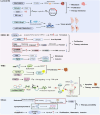Research progress and application status of organoid in breast cancer subtypes
- PMID: 39720912
- PMCID: PMC11984363
- DOI: 10.17305/bb.2024.11450
Research progress and application status of organoid in breast cancer subtypes
Abstract
Breast cancer (BC) is a prevalent malignant tumor that poses a significant health risk to women. The complexity of basic BC research and clinical treatment is influenced by multiple factors, including age, fertility, hormone metabolism, molecular subtypes, and tumor grading and staging. Traditional in vitro models often fall short of meeting modern research demands, whereas organoids-an emerging 3D primary culture technology-offer a unique platform that better replicates the tumor microenvironment (TME). Coupled with advances in high-throughput sequencing technologies, organoids have become increasingly valuable in biological and chemical research. Currently, the most widely used organoid model in BC research is the patient-derived organoid (PDO) model, which is generated directly from original tumor tissues. This paper aims to summarize the current status of PDO models across various BC subtypes, highlighting recent advances in genetics, mechanisms of drug resistance, identification of new therapeutic targets, and approaches to personalized treatment. In conclusion, the development of clinical precision medicine urgently requires in vitro models capable of accurately simulating the unique molecular subtypes of patients. This review will examine the challenges and future prospects of organoid models in BC research, offering new insights into the fundamental mechanisms of BC and paving the way for more effective personalized therapies.
Conflict of interest statement
Conflicts of interest: The authors declare no conflict of interest.
Figures


Similar articles
-
Progress and perspective of organoid technology in breast cancer research.Chin Med J (Engl). 2024 Sep 20;137(18):2157-2168. doi: 10.1097/CM9.0000000000002889. Epub 2024 Jan 8. Chin Med J (Engl). 2024. PMID: 38185826 Free PMC article. Review.
-
Breast cancer organoids from malignant pleural effusion-derived tumor cells as an individualized medicine platform.In Vitro Cell Dev Biol Anim. 2021 May;57(5):510-518. doi: 10.1007/s11626-021-00563-9. Epub 2021 May 5. In Vitro Cell Dev Biol Anim. 2021. PMID: 33950403
-
Breast cancer organoids and their applications for precision cancer immunotherapy.World J Surg Oncol. 2023 Oct 26;21(1):343. doi: 10.1186/s12957-023-03231-2. World J Surg Oncol. 2023. PMID: 37884976 Free PMC article. Review.
-
Patient-derived organoids in human cancer: a platform for fundamental research and precision medicine.Mol Biomed. 2024 Feb 12;5(1):6. doi: 10.1186/s43556-023-00165-9. Mol Biomed. 2024. PMID: 38342791 Free PMC article. Review.
-
The Use of Patient-Derived Organoids in the Study of Molecular Metabolic Adaptation in Breast Cancer.Int J Mol Sci. 2024 Sep 29;25(19):10503. doi: 10.3390/ijms251910503. Int J Mol Sci. 2024. PMID: 39408832 Free PMC article. Review.
References
-
- Bray F, Laversanne M, Sung H, Ferlay J, Siegel RL, Soerjomataram I, et al. Global cancer statistics 2022: GLOBOCAN estimates of incidence and mortality worldwide for 36 cancers in 185 countries. CA Cancer J Clin. 2024 May;74(3):229–63. https://doi.org/10.3322/caac.21834. - PubMed
-
- Yu J, Huang W. The progress and clinical application of breast cancer organoids. Int J Stem Cells. 2020 Nov 30;13(3):295–304. https://doi.org/10.15283/ijsc20082. - PMC - PubMed
-
- Ebrahimi N, Nasr Esfahani A, Samizade S, Mansouri A, Ghanaatian M, Adelian S, et al. The potential application of organoids in breast cancer research and treatment. Hum Genet. 2022 Feb;141(2):193–208. https://doi.org/10.1007/s00439-021-02390-0. - PubMed
-
- Ben-David U, Ha G, Tseng YY, Greenwald NF, Oh C, Shih J, et al. Patient-derived xenografts undergo murine-specific tumor evolution. Nat Genet. 2017 Nov;49(11):1567–75. https://doi.org/10.1038/ng.3967. - PMC - PubMed
-
- Ingber DE. Human organs-on-chips for disease modelling, drug development and personalized medicine. Nat Rev Genet. 2022 Aug;23(8):467–91. https://doi.org/10.1038/s41576-022-00466-9. - PMC - PubMed

